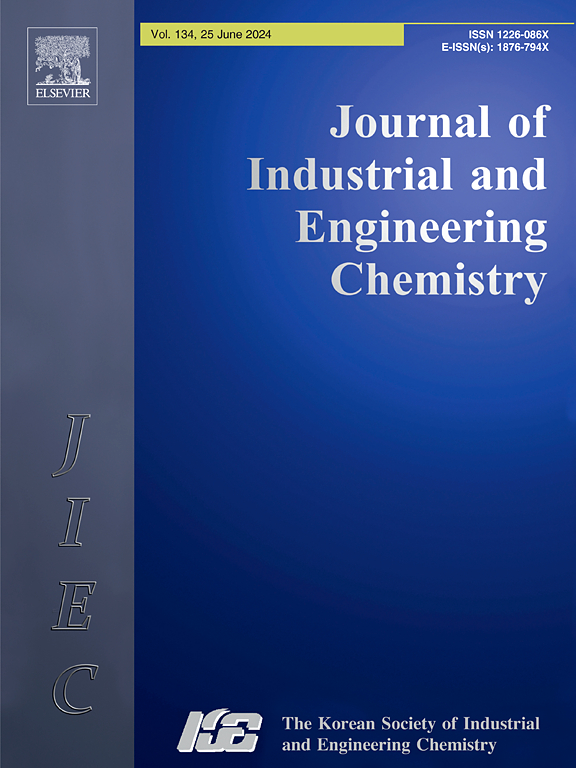Recent updates on a Cs3Bi2Br9-based heterojunction photocatalyst for selective CO2 conversion into (CO/CH4) products
IF 5.9
3区 工程技术
Q1 CHEMISTRY, MULTIDISCIPLINARY
Journal of Industrial and Engineering Chemistry
Pub Date : 2025-01-27
DOI:10.1016/j.jiec.2025.01.029
引用次数: 0
Abstract
Composite engineering has the potential to convert CO2 into high-value products, addressing energy scarcity and environmental challenges. In particular, the Cs3Bi2Br9 perovskite has garnered significant attention for activating inert CO2 molecules, benefiting from its stability, lower defect density, tunable electronic structure, and high photoluminescence quantum efficiency (PLQE) value. Additionally, compounding Cs3Bi2Br9 with other components can further enhance its potential, modifying photo redox and CO2 adsorption/activation, leading to regulated C1 product selectivity. Herein, the review summarises different strategies for constructing Cs3Bi2Br9-based heterostructures and discusses advanced experimental techniques to support the shreds of evidence for the functioning of charge migration. Afterwards, the selectivity of Cs3Bi2Br9-based heterojunction for CO2 photoreduction reactions has been thoroughly comprehended. Lastly, the review also summarized conclusive remarks and future perspectives of Cs3Bi2Br9-based heterojunction on the photocatalytic conversion of CO2.

基于cs3bi2br9的选择性CO2转化为(CO/CH4)产物的异质结光催化剂的最新进展
复合材料工程有潜力将二氧化碳转化为高价值产品,解决能源短缺和环境挑战。特别是Cs3Bi2Br9钙钛矿,由于其稳定性、缺陷密度低、电子结构可调、光致发光量子效率(PLQE)值高,在激活惰性CO2分子方面受到了广泛关注。此外,Cs3Bi2Br9与其他组分复配可以进一步增强其潜力,修饰光氧化还原和CO2吸附/活化,从而调节C1产物的选择性。本文综述了构建基于cs3bi2br9异质结构的不同策略,并讨论了先进的实验技术,以支持电荷迁移功能的证据。随后,深入了解了cs3bi2br9基异质结对CO2光还原反应的选择性。最后,对cs3bi2br9基异质结在CO2光催化转化中的研究进展进行了总结和展望。
本文章由计算机程序翻译,如有差异,请以英文原文为准。
求助全文
约1分钟内获得全文
求助全文
来源期刊
CiteScore
10.40
自引率
6.60%
发文量
639
审稿时长
29 days
期刊介绍:
Journal of Industrial and Engineering Chemistry is published monthly in English by the Korean Society of Industrial and Engineering Chemistry. JIEC brings together multidisciplinary interests in one journal and is to disseminate information on all aspects of research and development in industrial and engineering chemistry. Contributions in the form of research articles, short communications, notes and reviews are considered for publication. The editors welcome original contributions that have not been and are not to be published elsewhere. Instruction to authors and a manuscript submissions form are printed at the end of each issue. Bulk reprints of individual articles can be ordered. This publication is partially supported by Korea Research Foundation and the Korean Federation of Science and Technology Societies.

 求助内容:
求助内容: 应助结果提醒方式:
应助结果提醒方式:


